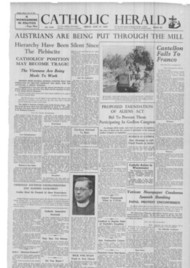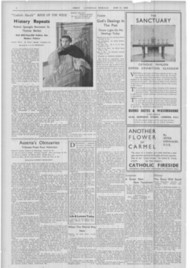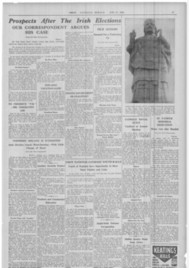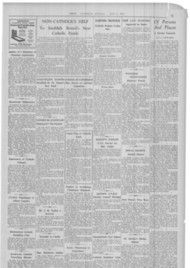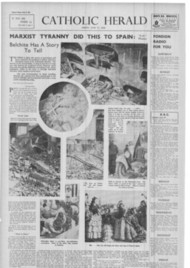Page 12, 17th June 1938
Page 12

Report an error
Noticed an error on this page?If you've noticed an error in this article please click here to report it.
Tags
Share
Related articles
Could En Lishme Cad He Ible In English Efore The Eformation?
The 13111le In England War Among The Scholars
Notes For Ransomers
It is difficult to exaggerate the importance attached to pilgrimages by our preReformation forefathers," says Cardinal Gasquet in his book, The Eve of the Reformation. "From very early times the practice was followed with eagerness, not to say with devotion, and included not merely visits to the shrines situated within the country itself, but long and often perilous journeys into foreign lands—to Compostella, Rome and to the Holy Land itself."
While " if Englishmen went abroad to the celebrated shrines, foreigners in turn found their way to the no less renowned places of pilgrimage in England. Piligrims' inns and places of rest were scattered over
the great roads leading to Glastonbury,
Walsingham and Canterbury, and other 'holy spots.' in this island, and at times these places were thronged with those who came to pay their devotion. At one time we are told that more than a hundred thousand pilgrims were together in the city of Canterbury to celebrate one of the jubilee celebrations of the martyr, St. Thomas; whilst the road to Walsingham was so much frequented that, in the common mind, the very milky way ' had been set by Providence in the heavens to point the path to Our Lady's shrine."
To the Guild of Our Lady of Ransom belongs the honour of restoring and fostering devotion to Our Lady, the Saints and MartYrs, by organising pilgrimages to the old English shrines.
Reviving Pilgrimages Canterbury was the first pilgrimage to be revived, in 1889, in honour of the great defender of the rights of the Church—St.
Thomas of Canterbury.
York pilgrimage was intended to be to the north country what Canterbury was to the south. Beneath the floor of the glorious Minster nave rests the body of St. William of York, and here the pilgrims come to kneel in silent prayer after the pilgrimage, Mass and sermon.
These were at first at St. Wilfrid's Catholic church in the very shadow of the Minster, but now the authorities allow us the use of the ruins of York Abbey, and there the altar is set up and High Mass is sung with the help of a Benedictine choir from Ampleforth.
This pilgrimage is also in honour of the martyrs who suffered for the Faith at the York Tyburn, and especially of the Blessed Margaret Clitheroe, the Pearl of York, who was crushed to death for harbouring priests. Their relics are venerated at the Bar Convent.
The next in order was the pilgrimage in honour of Our Lady of Walsingham. Fr. Philip Fletcher in his delightful book of
reminiscences, Recollection of a Ransomer* tells us how this began.
Fr. Fletcher became acquainted with " Father George Wrigglesworth, the priest of King's Lynn, Norfolk . . . we became and remained fast friends. We made a pact that we would revive the great pilgrimage to Our Lady of Walsingham. Nothing was left of the old shrine except the east window and the wishing wells, the last name being applied by Protestants to the holy wells, once miraculous.
" Walsingham is some thirty miles from King's Lynn, but had no Catholic church at that time. . . It is a small village with a number of public-houses. These were once hostels for the innumerable pilgrims who flocked to the shrine of Our Lady. The object of veneration at Walsingham was a copy or model of the Holy House of Nazareth (now at Loreto) and all the devotions and pilgrimages to it were in honour of the Incarnation. The shrine was erected in the eleventh century by a noble lady of Walsingharn . . . who was favoured with a sight of the Holy House of Nazareth and told to build one like it at Walsingham.
" Father Wrigglesworth, desirous of reviving the Walsingham shrine, had his Lady-chapel in his new church made into a miniature Holy House. Every brick was in the same place as it is now at Loreto. The image of Our Lady is in wood, carved at Amrnergau and painted by Mr. Charles Rock, a devoted Ransomer. The figure of Our Lady was copied from the ancient picture of Santa Maria in Cosrnedin, Pope Leo XIII choosing that, as the original image of Our Lady of Walsingham was destroyed at the Reformation. By command of the said Pope the shrine at King's Lynn is to be regarded as that of Our Lady of Walsingham.' Fifteen lamps burn there and daily prayer has been offered nfl day for the conversion of England."
Britain's Proto-Martyr Another of the pilgrimages organised by the Guild is that to St. Albans in honour of the proto-martyr of Britain. This used to be held generally on the Saturday nearest to the feast of St. Alban. Now it is held on a Sunday, and this year will take place on June 19. St. Albans is within so short a distance of London and so easy of access that many more pilgrims might take part in this great act of devotion, and we hope that this year will see a great increase in the numbers present.
If you wish for further particulars about any of these or other pilgrimages and processions, or of the other objects and activi
ties of the Guild, write to the Secretary, Guild of Our Lady of Ransom, 29, Portugal Street, Lincoln's Inn, W.C.2.
blog comments powered by Disqus


